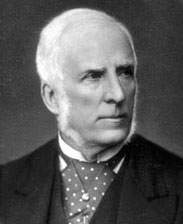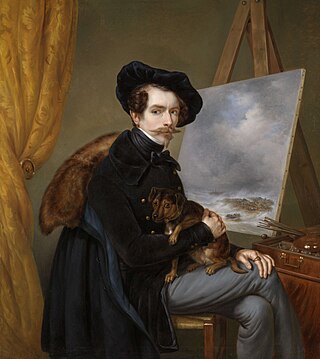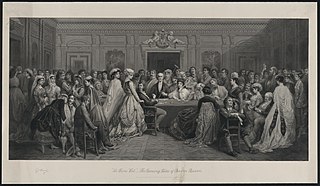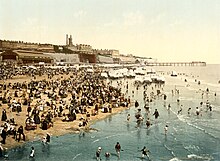
Joseph Mallord William Turner, known in his time as William Turner, was an English Romantic painter, printmaker and watercolourist. He is known for his expressive colouring, imaginative landscapes and turbulent, often violent marine paintings. He left behind more than 550 oil paintings, 2,000 watercolours, and 30,000 works on paper. He was championed by the leading English art critic John Ruskin from 1840, and is today regarded as having elevated landscape painting to an eminence rivalling history painting.

John Constable was an English landscape painter in the Romantic tradition. Born in Suffolk, he is known principally for revolutionising the genre of landscape painting with his pictures of Dedham Vale, the area surrounding his home – now known as "Constable Country" – which he invested with an intensity of affection. "I should paint my own places best", he wrote to his friend John Fisher in 1821, "painting is but another word for feeling".
A seaside resort is a town, village, or hotel that serves as a vacation resort and is located on a coast. Sometimes the concept includes an aspect of official accreditation based on the satisfaction of certain requirements, such as in the German Seebad. Where a beach is the primary focus for tourists, it may be called a beach resort.

William Powell Frith was an English painter specialising in genre subjects and panoramic narrative works of life in the Victorian era. He was elected to the Royal Academy in 1853, presenting The Sleeping Model as his Diploma work. He has been described as the "greatest British painter of the social scene since Hogarth".

Margate is a seaside town on the north coast of Kent in south-east England. The town is estimated to be 1+1⁄2 miles long, 16 miles north-east of Canterbury and includes Cliftonville, Garlinge, Palm Bay and Westbrook.

The Ramsgate tugs were a series of tugboats used at Ramsgate harbour since the 19th century. The harbour's development coincided with the growing use of the steam tugs that were then being built for the shipping industry.

John Callcott Horsley RA was an English academic painter of genre and historical scenes, illustrator, and designer of the first Christmas card. He was a member of the artist's colony in Cranbrook.

Turner Contemporary is one of the UK's contemporary art galleries. Celebrating Margate’s connection with the painter J. M. W. Turner, an artist who believed that art could be an agent of change, its year-round exhibition programme offers free access to creative and cultural experiences.

George Elgar Hicks was an English painter during the Victorian era. He is best known for his large genre paintings, which emulate William Powell Frith in style, but was also a society portraitist.

Ramsgate as a name has its earliest reference as 'Ramisgate' or 'Remmesgate' in 1275, from Anglo-Saxon 'Hraefn's geat, or 'Raven's cliff gap', later to be rendered 'Ramesgate' from 1357.

A Private View at the Royal Academy, 1881 is a painting by the English artist William Powell Frith exhibited at the Royal Academy of Arts in London in 1883. It depicts a group of distinguished Victorians visiting the Royal Academy Summer Exhibition in 1881, just after the death of the Prime Minister Benjamin Disraeli, whose portrait by John Everett Millais was included on a screen at the special request of Queen Victoria. The room is Gallery III, the largest and most imposing room at Burlington House.
Margate was a "limb" of Dover in the ancient confederation of the Cinque ports. It was added to the confederation in the 15th century.
John Gully was a New Zealand landscape painter.
Charles Bentley, was an English watercolour painter of coastal and river scenery.

The Derby Day is a large oil painting showing a panoramic view of The Derby, painted by William Powell Frith over 15 months from 1856 to 1858. It has been described by Christie's as Frith's "undisputed masterpiece" and also "arguably the definitive example of Victorian modern-life genre."

Pegwell Bay, Kent – a Recollection of October 5th 1858 is an oil-on-canvas painting by British artist William Dyce, depicting the landscape at Pegwell Bay, on the east coast of Kent. Considered a Pre-Raphaelite work, Dyce employs a mode of heightened realism and intricate detail to create a powerful landscape. It is considered to be Dyce's best painting, and is held by the Tate Gallery.

Johan Hendrik Louis Meijer was a Dutch painter, etcher, lithographer, and draftsman. He painted in the Romantic tradition and is best known for his seascapes.

Salon D'Or, Homburg, is an 1871 oil painting by William Powell Frith. It is held by the Rhode Island School of Design Museum in Providence, Rhode Island.
Emily Anne Peasgood is an Ivors Composer Awards winning English composer and sound artist. She is the niece of actress and television presenter Julie Peasgood.

The Railway Station is an 1862 genre painting by the British artist William Powell Frith. It depicts a scene at the busy Paddington Station railway terminus of the Great Western in London. Frith had developed a reputation for producing crowd scenes of everyday life, including Ramsgate Sands (1854) and The Derby Day (1858). Frith himself was doubtful about the potential work noting "I don't think the station at Paddington could be called picturesque, nor can the clothes of the ordinary traveller be said to offer much attraction to the painter", but was persuaded by his art dealer Louis Flatow who offered him reportedly the largest commission fee ever offered to an artist.
















